Your cart is currently empty!
On Biases in Books

As an FYI, this article is going to cover some later storyline points in Her Majesty’s Royal Coven by Juno Dawson, so if you’ve not read that book, plan on reading it, and don’t want it to be spoiled, please come back.
I’m not sure why this hit me so hard in this book, because reading fantasy for as long as I have, you come across quite a bit of casual racism and institutional or systemic issues within stories. The TERF (trans-exclusionary radical feminism) storyline within Dawson’s novel at some points made my stomach turn. Perhaps because it was the central pinch point of the story – what defines a woman? Or perhaps because it was set in at least a 20th-century alternative Britain?
Irregardless of the fact that the TERF-character ended up being nearly literally burned at the stake even though she was the leader of all the government witches in the UK at the time.
Now, I have done a bit of research and Juno herself is trans, so in many ways I can imagine and have sympathy (though not empathy, I myself, while queer, am not trans) for her decision to include this storyline and the — while not aggressive, quite blunt — depiction of a woman in power as a TERF. It doesn’t sit well with me, and maybe that’s the point. Maybe the point is to make readers uncomfortable with this main character. Which is in many stories, entirely valid. Her own memoir, perhaps.
To me, the discomfort came not because of the bluntness and unflinching nature of the TERF content on the page, but because, to me, it’s presence overrode the movement of the plot and the concept of this piece of content being a cohesive novel. Points in the book felt like the TERF perspective was forced into the narrative to include another gut punch, another uncomfortable moment for the reader where they were asked to sit with the idea and recognise the character in their own friends and family, the “hidden” biases, rather than moving along the plot. Instead, there were a number of moments where it felt like the eye of a hurricane, standing in the still moments and lingering for pages too long.
I’m not necessarily asking for a more nuanced take on this TERF character, sometimes villains are allowed to be 2D (and this one is definitely a take on a Twitter-active writer of a formerly-beloved children’s wizarding series, so hats off to Juno for that send up), but I wish this book was edited a bit more tightly, that there was a little bit less of what feels like pontificating, of getting up on the soapbox, I feel like the novel and the world would be so much stronger for it (It reminds me a bit of some of the later Sword of Truth books by Terry Goodkind, iykyk).
I don’t know if I’ll pick up the sequel to this book because if the meta-social commentary on the space and place for trans folk is as dense, I’m not sure I’ll be able to swim through it. What are your thoughts?

Leave a Reply